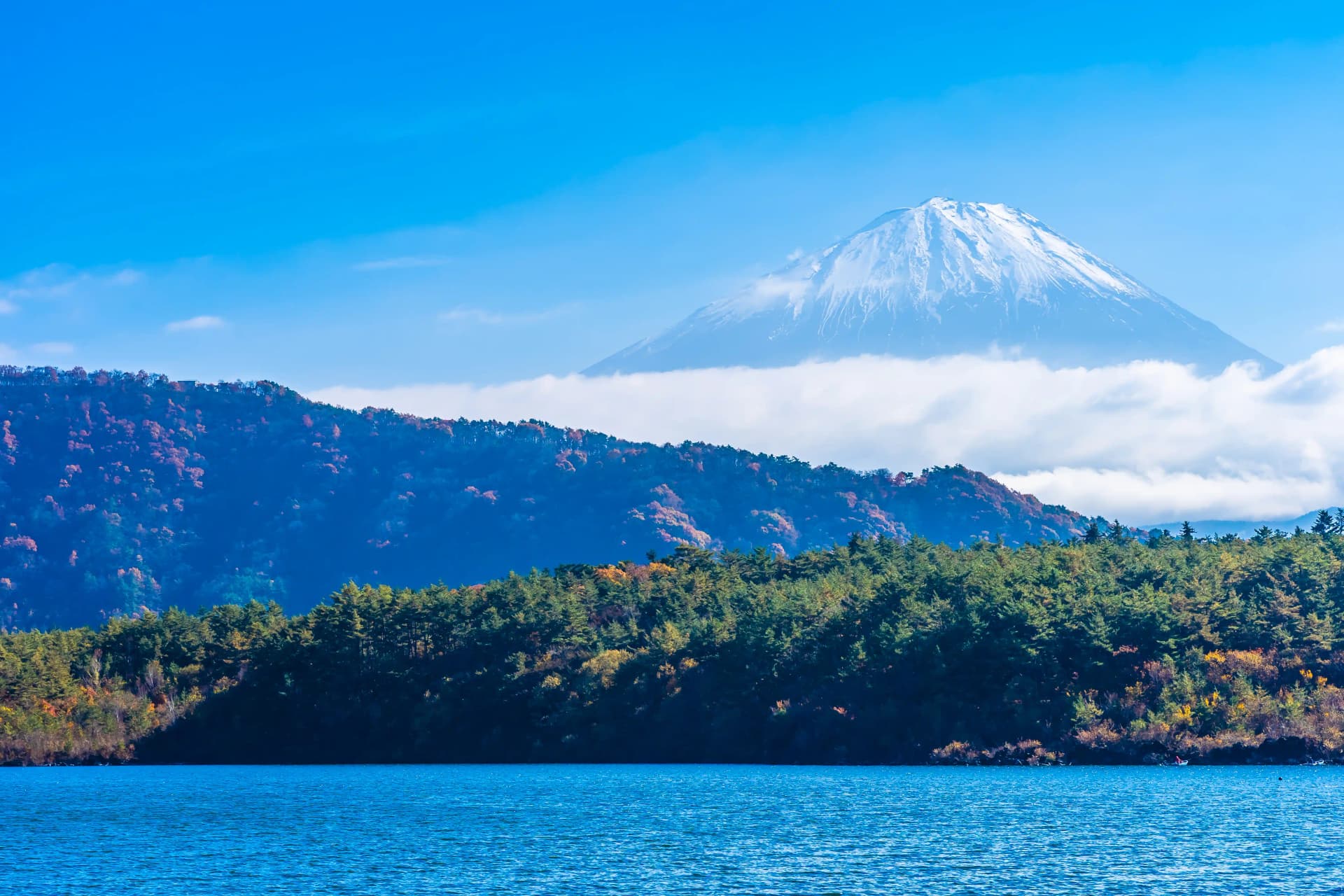
Japan’s 5 Most Stunning Mountain Peaks Beyon The Fuji
Japan’s landscapes are defined by towering peaks, each with its own unique story. Of course, no discussion of Japan’s mountains is complete without Mount Fuji—the nation’s most iconic peak. Standing at 3,776 meters, this near-perfect volcanic cone is a UNESCO World Heritage Site and a symbol of Japanese culture, art, and spirituality. Every year, thousands of climbers ascend to its summit for a once-in-a-lifetime sunrise above the clouds, while others admire its grandeur from afar, whether reflected in Lake Kawaguchi or framed by cherry blossoms in spring.
Beyond Mount Fuji, Japan boasts countless awe-inspiring mountains, each with its own distinct charm. From the sacred peaks of Dewa Sanzan to the volcanic landscapes of Mount Aso, here are five of the country’s most stunning mountains beside Mount Fuji that deserve a spot on your travel list.

Top 5 Mountain Peaks Beyon Mount Fuji in Japan
Mount Hakusan
Straddling Ishikawa, Gifu, and Fukui Prefectures, Mount Hakusan is one of Japan’s revered “Three Holy Mountains” alongside Mount Tateyama and Mount Fuji. This volcanic peak, steeped in spiritual tradition, captivates visitors with its diverse landscapes, from lush forests and alpine meadows to rugged volcanic terrain.
Pilgrims and hikers can ascend through scenic trails, encountering ancient shrines nestled amid nature. At the summit, a small sacred shrine stands in homage to Hakusan’s deity, reflecting the mountain’s deep spiritual significance.
On clear days, climbers are rewarded with breathtaking views stretching across the Sea of Japan and the Northern Japan Alps. Whether you seek adventure, tranquility, or a cultural journey, Mount Hakusan offers an unforgettable experience in Japan’s untouched wilderness.

Mount Tateyama
Rising to 3,015 meters, Mount Tateyama is one of Japan's most breathtaking alpine destinations, forming part of the iconic Japan Alps. It is renowned for its rugged hiking trails, dramatic landscapes, and panoramic mountain views.
Accessible via the Tateyama Kurobe Alpine Route, this majestic peak offers a seamless blend of adventure and natural beauty. Along the way, travelers can marvel at the stunning Mikurigaike Pond, a crystal-clear volcanic lake that reflects the surrounding peaks.
Tateyama comprises three primary summits:
- Oyama (3,003 m): Home to the sacred Oyama Shrine, a revered pilgrimage site.
- Onanjiyama (3,015 m): The highest of the three, offering unparalleled views.
- Fuji no Oritate (2,999 m): Named for its resemblance to Mount Fuji from certain angles.
Visitors can explore the area using cable cars and alpine trails, immersing themselves in the pristine wilderness. Whether you're an avid hiker or a casual traveler, Mount Tateyama promises an unforgettable encounter with Japan’s high-altitude wonders.

Mount Rishiri
Rising dramatically from the Sea of Japan, Mount Rishiri is a volcanic peak that dominates Rishiri Island, just off Hokkaido’s northernmost coast. Nicknamed "Rishiri-Fuji" for its striking resemblance to Mount Fuji, this isolated summit offers a fairytale-like landscape—snow-draped in winter, and vibrant with wildflowers in summer.
A summertime ascent rewards hikers with breathtaking 360-degree views of lush wetlands, dense forests, and the surrounding sea. On clear days, you can even spot Rebun Island, another scenic jewel of the Rishiri-Rebun-Sarobetsu National Park.
The official climbing season runs from early July to early October, making it an ideal summer adventure for nature lovers and seasoned hikers alike. Whether you're trekking to the top or simply admiring the island’s raw beauty, Mount Rishiri is an unforgettable destination for those exploring Hokkaido’s wild north.

Dewa Sanzan
Nestled in Yamagata Prefecture, the Dewa Sanzan—Mount Haguro, Mount Gassan, and Mount Yudono—are among Japan’s most revered spiritual sites. These three peaks form the heart of Shugendō, a mystical mountain faith blending Shinto, Buddhism, and nature worship.
Each mountain symbolizes a different stage of existence:
- Mount Haguro (414 m): Represents the present, where worshippers pray for blessings in this life. Its five-story pagoda and ancient cedar-lined path create a truly atmospheric experience.
- Mount Gassan (1,984 m): Embodies the past, where visitors pay homage to their ancestors. Its summit shrine, often shrouded in mist, exudes an ethereal charm.
- Mount Yudono (1,504 m): This signifies rebirth and the future, featuring a secluded shrine where spiritual renewal rituals take place.
Travelers seeking cultural immersion can stay at shukubō temple lodgings, run by yamabushi mountain priests. These accommodations offer a rare chance to experience monastic life, including traditional vegetarian shōjin ryōri cuisine and guided rituals. A pilgrimage to Dewa Sanzan isn’t just a journey through Japan’s spiritual heritage—it’s a path to self-discovery and enlightenment.

Mount Aso
Towering over central Kyushu, Mount Aso is one of the world’s largest active volcanoes, offering some of Japan’s best hiking, cycling, and scenic drives. Shaped by millennia of eruptions, this geological wonder sits at the heart of Aso-Kuju National Park, one of Japan’s first designated national parks.
Visitors can explore the emerald-green plains of Kusasenri, admire the dramatic cliffs of Sensui Gorge, or unwind in a traditional onsen village nestled at the mountain’s base. For adventurers, a highlight is trekking along Aso’s crater rim, where breathtaking panoramic views of the vast caldera await.
Road trippers will love the Aso Panorama Line, a winding mountain road that showcases Aso’s volcanic landscapes in all its glory. Whether you're here for an active escape or a relaxing retreat, Mount Aso promises an unforgettable experience in Kyushu’s untamed wilderness.

Conclusion
Japan’s mountains are more than just breathtaking landscapes—they are gateways to adventure, spirituality, and cultural discovery. Whether you’re trekking the sacred trails or soaking in the alpine beauty, each peak offers an unforgettable journey into Japan’s wild heart. So, lace up your boots, grab your camera, and set off on an adventure to conquer Japan’s most stunning peaks!
Articles for you

Top 5 Best National Parks in Japan For First-Time Travelers
Japan is a land of breathtaking contrasts—where ancient traditions meet cutting-edge technology, and towering peaks give way to serene coastlines. Among its many natural wonders, Japan’s national parks stand out as treasures of biodiversity, cultural heritage, and outdoor adventure. From snow-capped volcanoes and crystal-clear lakes to pristine forests and rugged coastlines, these parks offer a gateway to some of the country’s most awe-inspiring landscapes.

5 Breathtaking Hiking Trails Near Tokyo You Can’t Miss
Japan’s diverse landscapes offer some of the most scenic and rewarding hikes in the world. Whether you’re looking for a peaceful forest walk, a cultural trek past ancient shrines, or a challenging hike with stunning Mount Fuji views, there’s a trail for every adventurer. From the iconic peaks of Tokyo’s outskirts to hidden gems in Kanagawa and Ibaraki, these trails blend nature, history, and breathtaking panoramas into one unforgettable experience. Going through the 5 great hiking trails, each with its unique charm and various difficulties suitable for both casual explorers and seasoned hikers, these journeys promise stunning views, fresh air, and a deep appreciation for Japan’s natural beauty. Ready to lace up your hiking boots? Let’s hit the trails!

Top 6 Off-The-Beaten Paths You Can Get To By Train in Japan
Railway travel in Japan is a dream for train enthusiasts. The country’s extensive rail network not only provides fast and budget-friendly connections between major cities but also offers a seamless way to explore its hidden gems. Beyond the bustling urban hubs, Japan’s railway systems grant access to breathtaking remote destinations—letting you soak in stunning landscapes without the stress of driving. Let’s travel to these 6 hidden gems you can easily get to by train in Japan.

6 Unique Festivals In Japan First-Time Travelers Should Not Miss
Japan is one of the most interesting tourist destinations around the world where cutting-edge technology intertwines with ancient traditions. Its traditions are brought to life through vibrant festivals (matsuri) and cultural local celebrations. From the thrilling clashes of danjiri floats to the graceful rituals of rice planting, each festival tells a unique story, offering visitors chances to witness and even participate in centuries-old customs.
Be mesmerized by the beauty of illuminated celebrations and sacred connection to Japan’s ancient roots with these top 6 unique festivals first-time travelers should not miss.




